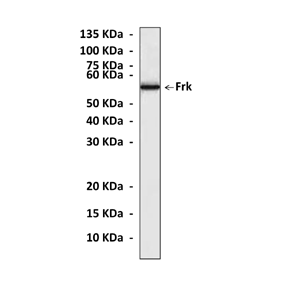Anti-Frk: Mouse Fyn Related Kinase Antibody |
 |
BACKGROUND Brk, Srm, Frk, and Src42A form a distinct family of Intracellular Src-like tyrosine kinases. They have a low degree of sequence homology to other known kinases, including one another. The exon structure of these kinases is highly conserved and distinct from each of the major families of intracellular kinases containing SH3, SH2, and tyrosine kinase domains, including c-Src and Fyn. Brk and Srm are 1.1 kb apart on human chromosome 20q13.3 and likely are the result of duplication in cis. Several Brk family kinases have an inhibitory effect on Ras pathway signaling from receptor tyrosine kinases. Members of this family can act either in the membrane or at the nucleus, and may change localization patterns depending on external stimuli. Brk has been shown to phosphorylate two proteins in vivo: Sam68, a substrate for Src in mitosis that can substitute for Rev in nuclear export of RNAs; and BKS, a novel adaptor molecule. Brk also functions as a rapid downstream signaling intermediate following calcium- induced differentiation in keratinocytes. It is possible that Brk family kinases may share common functions and interaction partners, which remain for the most part unexamined.1
Frk (fyn-related kinase), also called Rak/Gtk/Bsk/Iyk (where Gtk stands for gut tyrosine kinase, Bsk for β-cell Src-homology kinase and Iyk for intestinal tyrosine kinase), is a cytoplasmic tyrosine kinase belonging to the Src-like Brk family. Frk is expressed in liver, lung, kidney, mammary-gland epithelium, intestine and the pancreas including islets. Previous studies have suggested Tyr-497 and Tyr-504 in the C-terminus as potential regulators of kinase activity.2 Frk acts on a downstream adaptor protein called SH2 domain adaptor protein SHB. SHB is ubiquitously expressed and contains proline rich motifs, a phosphotyrosine binding (PTB) domain, tyrosine phosphorylation sites and an SH2 domain and serves a role in generating signaling complexes in response to tyrosine kinase activation. SHB mediates certain responses in PDGFR, FGFR, NGFR, TCR, IL-2R and FAK signaling. Frk and SHB exert similar effects when overexpressed in rat PC12 and beta-cells. The Frk-SHB responses involve FAK and insulin receptor substrates (IRS) -1 and -2. SHB is a versatile signal transduction molecule that produces diverse biological responses in different cell types under various conditions. SHB operates downstream of Frk in cells that express this kinase.3 Frk may have a potential role in centrosome structure and/or function, particularly in the context of regulation of cell division. Activated Frk/rak suppresses growth by inducing a G1 arrest of cell cycle4 and Frk is potentially a novel tumor suppressor gene for epithelial cancers regulating growth and/or morphological differentiation of epithelial cells.
REFERENCES
1. Serfas, M.S. & Tyner, A.L.: Oncol. Res. Featuring Preclin. Clin. Cancer Therapeut. 13: 409-419, 2003
2. Oberg-Welsh C, et al: Growth Factors 16:111-24, 1998
3. Anneren C. et al: Curr. Mol. Med. 3:313-324, 2003
4. Cravan, R.J. et al: Cancer Res. 55:3969-3972, 1995
2. Oberg-Welsh C, et al: Growth Factors 16:111-24, 1998
3. Anneren C. et al: Curr. Mol. Med. 3:313-324, 2003
4. Cravan, R.J. et al: Cancer Res. 55:3969-3972, 1995
Products are for research use only. They are not intended for human, animal, or diagnostic applications.
Параметры
Cat.No.: | CP10110 |
Antigen: | Purified recombinant human Frk fragments expressed in E. coli. |
Isotype: | Mouse IgG |
Species & predicted species cross- reactivity ( ): | Human |
Applications & Suggested starting dilutions:* | WB 1:1000 IP n/d IHC n/d ICC n/d FACS n/d |
Predicted Molecular Weight of protein: | 56 kDa |
Specificity/Sensitivity: | Setects endogenous Frk proteins without cross-reactivity with other family members. |
Storage: | Store at -20°C, 4°C for frequent use. Avoid repeated freeze-thaw cycles. |
*Optimal working dilutions must be determined by end user.
Документы
Информация представлена исключительно в ознакомительных целях и ни при каких условиях не является публичной офертой








